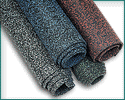 It’s kind of interesting, really. Of course, I’m fascinated by how about everything is manufactured, so I’m easily impressed.
It’s kind of interesting, really. Of course, I’m fascinated by how about everything is manufactured, so I’m easily impressed.
Anyway, in short, you basically take ground up tires and throw those into a big vat. Into that, you mix a certain percentage of colored rubber – many rubber rolls are made with 10% color chips added to the mix, but percentages can go up to 50% or even higher in some cases. The more color chips, the more color you will see against the background of black reground material, when it is cut into rolls. Into this is mixed a binder, which is essentially an adhesive that holds all this mixture together.
The vat is then capped off and heated, which will then produced a large cylinder of solid rubber. This cylinder is typically 3’ or 4’ tall, which is why most rubber rolls and tiles come in either 3’ or 4’ widths. After the cylinder cools, it is set on its side and shaved with blade that is set to cut the thickness of the flooring roll. 3/8” is a pretty common size in our market, but the material can typically be cut as thin as 1/8” and up to ½”. Since this is all being shaved off a cylinder, virtually any length roll can made.
From there, the rolls can either be sold as is, or further cut widthwise into square-cut tiles, or cut by a water-jet cutter into interlocking tiles. Not all tiles are made this way, with some companies making the tiles in molds, using a similar mixing process and slicing a large block into sheets. But all rubber rolls are made using this process.
Now you know why rubber flooring is typically available in 3’ or 4’ widths!
